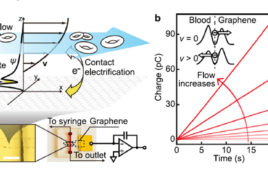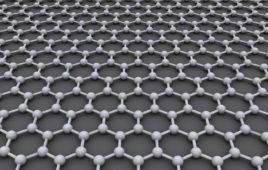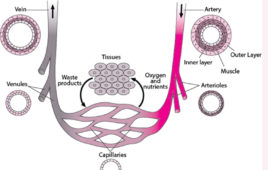 A Northwestern University-led team recently found the answer to a mysterious question that has puzzled the materials science community for years—and it came in the form of some surprisingly basic chemistry.
A Northwestern University-led team recently found the answer to a mysterious question that has puzzled the materials science community for years—and it came in the form of some surprisingly basic chemistry.
Like many scientists, Jiaxing Huang did not understand why graphene oxide (GO) films were highly stable in water. When submerged, the individual GO sheets become negatively charged and repel each other, which should cause membrane to disintegrate. But earlier papers noted that instead of disintegrating, the films stabilized.
“It doesn’t make any sense,” says Huang, associate professor of materials science and engineering at the McCormick School of Engineering. “Many scientists have been very puzzled by this.”
Graphene oxide, a product of graphite oxidation, is often used to make graphene, a single-atom-layer thick sheet of carbon that is remarkably strong, lightweight, and has high potential in electronics and energy storage. Within the past three years, however, more scientists have become interested in GO itself, partially because of its potential for molecular separation applications.
After studying the material for many years, Huang realized that the secret of GO’s mysterious insolubility was the unintentional introduction of a common contaminant. To make a GO film, many scientists pass the acidic dispersion of individual sheets through porous anodized aluminum oxide filter discs, which are popularly used for preparing membranes of many nanomaterials. Huang’s team found that during filtration, the aluminum filter discs corrode in acidic water to release a significant number of aluminum ions, Al3+. The positively charged ion bonds with the negatively charged GO sheets to stabilize the resulting membranes.
“We have solved the puzzle using essentially freshman-level inorganic chemistry,” Huang says. “Now we know that graphene oxide films are indeed soluble in water. It’s just a matter of sample purity.”
Other multivalent metal ions, such as manganese, which is a byproduct from the synthesis of GO, can also crosslink the sheets.
Huang’s research is described in “On the origin of stability of graphene-oxide membranes in water,” published in Nature Chemistry on Jan. 5. Other authors of the paper include graduate student Che-Ning Yeh, postdoc Kalyan Raidongia, former visiting graduate student Jiaojing Shao, and Shao’s former adviser Quan-Hong Yang from Tianjin University in China. The National Science Foundation and Office of Naval Research funded different parts described in the paper.
Huang’s finding also indicated that GO films are not as strong as researchers once thought. The aluminum ions make the film much stiffer. Without the ions, GO is three to four times weaker.
“This is a wake-up call for anyone using aluminum oxide filter discs,” he says. “People have used it for sample preparation in many areas of materials science and biology. Now we know it’s not as clean as we think.”
Release Date: January 5, 2015
Source: Northwestern University




